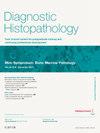Transforming pathology into digital pathology: highway to hell or stairway to heaven?
引用次数: 0
Abstract
Digital Pathology (DP) is revolutionizing diagnostic surgical pathology, transitioning from traditional microscopy to digital workflows that enhance diagnostic accuracy, streamline processes, and enable cost efficiency. While fully digitized laboratories demonstrate improved efficiency and engagement, adoption remains uneven globally due to infrastructure, cost, and organizational barriers. As a result, European and Asian institutions demonstrate adoption of DP with varying strategies tailored to resource availability and goals. Here we highlight important issues when planning and implementing DP systems. Successful implementation requires robust IT infrastructure (server, random access memory, network speed), including integrated image management and laboratory information systems, and scalable storage solutions. Selecting the appropriate scanners and optimizing workflows are critical, guided by specific institutional needs such as slide volume, turnaround times, and digitization scope. Financially, DP demands significant initial investment but offers long-term benefits in operational efficiency, cost savings, and workforce optimization. Image analysis integration and national initiatives are key drivers for DP adoption, addressing diagnostic challenges and fostering collaboration. Overcoming obstacles such as high costs, technical complexity, and resistance from pathologists is essential. As technology advances and costs decrease, DP is poised to transform pathology with improved diagnostic workflows, quality control, and accessibility.
将病理学转变为数字病理学:通往地狱的高速公路还是通往天堂的阶梯?
数字病理学(DP)正在彻底改变外科病理学诊断,从传统的显微镜到数字工作流程,提高诊断准确性,简化流程,并实现成本效益。虽然完全数字化的实验室显示出更高的效率和参与度,但由于基础设施、成本和组织障碍,全球范围内的采用情况仍然不均衡。因此,欧洲和亚洲的机构采用了根据资源可用性和目标量身定制的不同策略的发展规划。在这里,我们强调了规划和实施DP系统时的重要问题。成功的实现需要健壮的IT基础设施(服务器、随机存取存储器、网络速度),包括集成的图像管理和实验室信息系统,以及可伸缩的存储解决方案。选择合适的扫描仪和优化工作流程是至关重要的,要根据特定的机构需求(如幻灯片数量、周转时间和数字化范围)进行指导。从财务上讲,DP需要大量的初始投资,但在运营效率、成本节约和劳动力优化方面具有长期效益。图像分析集成和国家倡议是DP采用的关键驱动因素,解决诊断挑战和促进合作。克服诸如高成本、技术复杂性和病理学家的阻力等障碍至关重要。随着技术的进步和成本的降低,DP有望通过改进诊断工作流程、质量控制和可及性来改变病理学。
本文章由计算机程序翻译,如有差异,请以英文原文为准。
求助全文
约1分钟内获得全文
求助全文
来源期刊

Diagnostic Histopathology
Medicine-Pathology and Forensic Medicine
CiteScore
1.30
自引率
0.00%
发文量
64
期刊介绍:
This monthly review journal aims to provide the practising diagnostic pathologist and trainee pathologist with up-to-date reviews on histopathology and cytology and related technical advances. Each issue contains invited articles on a variety of topics from experts in the field and includes a mini-symposium exploring one subject in greater depth. Articles consist of system-based, disease-based reviews and advances in technology. They update the readers on day-to-day diagnostic work and keep them informed of important new developments. An additional feature is the short section devoted to hypotheses; these have been refereed. There is also a correspondence section.
 求助内容:
求助内容: 应助结果提醒方式:
应助结果提醒方式:


